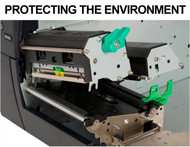Unraveling Thermal Transfer Printing: A Comparative Analysis of Flathead and Near Edge Technologies
Posted by JB on 7th Aug 2024
Exploring Thermal Transfer Printing: A Dive into Flathead and Near Edge Technologies
Grasping the Intricacies of Thermal Printing
To appreciate the inner workings of the printing and labeling world, one needs to comprehend the technologies behind the scenes. Thermal printing is a cornerstone in these industries, generating sharp texts and images for applications like tracking, shipping, and identification. In this discourse, we'll delve into two pivotal technologies of thermal transfer printing: flathead and near edge printing.
What Constitutes a Thermal Print Head?
Before unraveling the differences between flathead and near edge printing, let's first familiarize ourselves with the concept of thermal printing.
A thermal print head is an integral part of the printing system. It uses heat-sensitive materials such as thermal paper or ribbon to transfer ink onto a substrate. Electrical signals direct the generation of heat to specific areas to print corresponding images or text.
Understanding Thermal Printing Mechanics

At the heart of thermal printing is a heat-sensitive, carbon ribbon. The ribbon moves over the heated print head, causing the ink to melt and transfer onto the substrate below, hence creating the desired image or text.
Flathead and near edge printing, both unique types of technology, find use in thermal printing, each with their distinct printing variations. The core difference between these technologies lies in how the print head interacts with the ribbon and media. Each type affects the print quality, speed, ribbon utilized, and is separately found in certain thermal printer brands.
Let's delve deeper into both flathead and near edge printing, exploring their significance in thermal printing.
Flathead Thermal Transfer Printing
In flathead thermal printing, the print head assumes a flat, horizontal position against the ribbon and media. The heating elements are centered in the print head, causing the ink to transfer onto the media as the ribbon moves over the heated thermal print head.
Both the ribbon and media move together briefly, allowing the ink to cool and solidify. As such, the substrate and ribbon interact with the print head for a longer duration in flathead thermal printing.
Traditionally, flathead thermal transfer is the more prevalent choice, making it a common feature in printers available in the market. It functions optimally in medium volume-sized printers, which encompass all industrial and most desktop printers.
Brands Using Flathead Printing Include:
Near Edge Thermal Transfer Printing
Although less common and slightly more expensive, near edge printing plays an important role in thermal printing technology.
In near edge printing, the thermal print head is angled at 45 degrees, which often leads to near edge being referred to as the "floating head" or "corner edge" in the industry.
The substrate briefly interacts with the ribbon as it passes under the heated print head, resulting in an instant ink transfer onto the substrate. The print head gets a chance to cool down between prints, preventing a continuous rise in temperature, thus reducing print head wear.
Brands Using Near Edge Printing Include:
- Toshiba TEC
- Bell-Mark
- Avery Novexx (for tag printing)
- Videojet
Applications of Flathead and Near Edge Printing
Understanding the mechanisms of both flathead and near edge printing technologies sheds light on how they are applied. Each offers different advantages and disadvantages in their respective applications.
Flathead printing, being a standard form of printing, is used for most thermal transfer printing methods, including printing on paper and non-paper substrates that require a lot of print definition and resolution.
On the other hand, near edge printing is commonly found on consumer products, including items in the food and beverage industry for applications like expiration dates on packages. Soft, flexible materials like plastic and apparel fabrics also utilize near edge printing.
Print Head Cleaning & Maintenance
The thermal print head is undeniably the most essential part of a thermal printer. To maintain high print quality and consistent performance, regular cleaning of the thermal printer is vital. A failure to clean and maintain your print head could result in poor print quality, leading to losses in operational time and resources. Regular maintenance can prolong the life of your print head and maintain high-quality prints.
It is essential to clean the print head using cleaning supplies, such as alcohol-dampened cards or swabs, which are often provided with the printer at the time of purchase. Alternatively, a microfiber rag dampened with 70% isopropyl alcohol can be used to remove any ink residue on the print head.
In conclusion, both flathead and near edge thermal printing technologies have their unique advantages and applications, and understanding these can help users select the right printer

